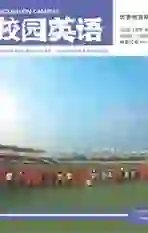中国古典诗歌互文符号的英译策略探究
2016-05-14宋章华
宋章华
【摘要】中国古典诗歌历史悠远,诗中互文标记之多,不一而足。所谓互文标记,衍生于互文理论。它是指在文学文本中存在的连接该文本与其他文本的字、词、句等连接成分。毋庸置疑,这些互文标记翻译的准确与否直接影响着诗歌在语义或是情感等方面的传达效度。为此,本文提出了一些较为可行的翻译策略。
【关键词】互文标记 互文理论 中国古典诗歌 英译策略
【Abstract】Endowed with a prolonged history, Chinese classical poems are replete with intertextual marks. Derived from the Intertextual theory, Intertextual marks refer to some words or sentences that function as links between the interrelated texts. Admittedly, the more accurately these intertextual marks are rendered, the more sufficiently word meanings and emotional overtones are conveyed. Therefore, this paper propounds several feasible translation strategies.
【Key words】intertextual marks; Intertextual theory; Chinese classical poetry; translation strategies
1. Introduction
Julia Kristeva, a well-reputed French semiotician, originally proposed the notion of intertextuality which is particularly coined as to clarify the interdependent relationship between texts. According to Julia Kristeva, all signifying systems from table settings to poems, are constituted by the manner in which they transform earlier signifying systems. Besides, any text is constructed of a mosaic quotations; any text is the absorption and transformation of another (Kristeva, 1969: 66). Derived from the Intertextual theory, Intertextual marks refer to some words or sentences that function as links between the interrelated texts.
Later, some poststructuralists had this intertextuality theory applied into translation studies, especially poetry translation. With plumbing into the depths of these handy translated versions, some practical strategies pertaining to intertextual marks translation can be construed and summarized, thus serving as a reference for the ensuing researches and studies.
2. Suggested Translation Strategies of Intertextual Marks
2.1 Literal Translation
Intertextual marks are more often than not expressive of the traditional culture that a certain country boasts of. Notwithstanding these unique cultural marks, there exist arrays of intertextual marks whose cultural connotation are fathomed worldwide. Under such condition, these intertextual marks can be appropriately translated by adopting literal translation. Here an example is illustrated as follows.
安居不用架高堂,书中自有黄金屋。
娶妻莫恨无良媒,书中自有颜如玉。
In this poem, “黄金屋” and “颜如玉” are intertextual marks that had be also employed in The Peony Pavilion (牡丹亭), one of the most acclaimed drama in ancient China. It goes like this: 谩说书中能富贵, 颜如玉, 和黄金屋在那里? In the aforementioned poem, the underlined characters “黄金屋” and “颜如玉” are translated respectively into “the room of yellow gold” and “the jade-smooth cheeks”, which, for one thing, enables readers to give their fancy to play that what a stunning beauty she is with her countenance likened to jade, and how imposing and grandiose the dwelling is with stacks of gold filled in, and for another, satisfies the psychological expectation of foreign readers for the oriental culture and exotic flavor.
2.2 Cultural Substitution
Cultural substitution refers to replacing the intertextual marks in the source language with an expression carrying the specific cultural connotation in the target language. Such an expression might not be equivalent to the meanings that the intertextual marks bear.
“杜宇” in the poem is an ubiquitous cultural image redolent of sadness and desperateness in Chinese literary works. It is also an intertextual mark that sweeps myriad works. Historically speaking, “杜宇” is a culture-loaded word in Chinese. How to translate “杜宇” has concerned many a translator. Yang Xianyi had it rendered into “cuckoo” while Hawks translated it into “nightingale”. Honestly speaking, cuckoo is not hued with any sorrow and grief whereas nightingale is literarily symbolic of sadness in western culture. John Keats once composed a poem entitled Ode to Nightingale in which nightingale represents gloom.
The translation strategy that Hawks adopted is the cultural substitution which circumvents the understanding barrier, thereby rendering the target readers palatable to the original.
3. Conclusion
This paper has put forward some practical translation strategies with a view to helping translators command how to translate intertextual marks more properly. Nevertheless, it is still a nut for scholars to crack in terms of how to more seamlessly incorporate the intertextual theory into the translation theory so as to present such a translated version which is commensurate with the original in various respects.
References:
[1]Cao,Xueqin.(1980).A dream of red mansions.(Trans.Yang Xianyi and Gladys Yang).Beijing:Foreign Language Press.
[2]Cao,Xueqin.(1987).The story of the stone.(Trans.David Hawks and Minfold).London:Penguin Books.
[3]蒋骁华.符号学翻译研究[M].北京:外语教学与研究出版社,2003.
